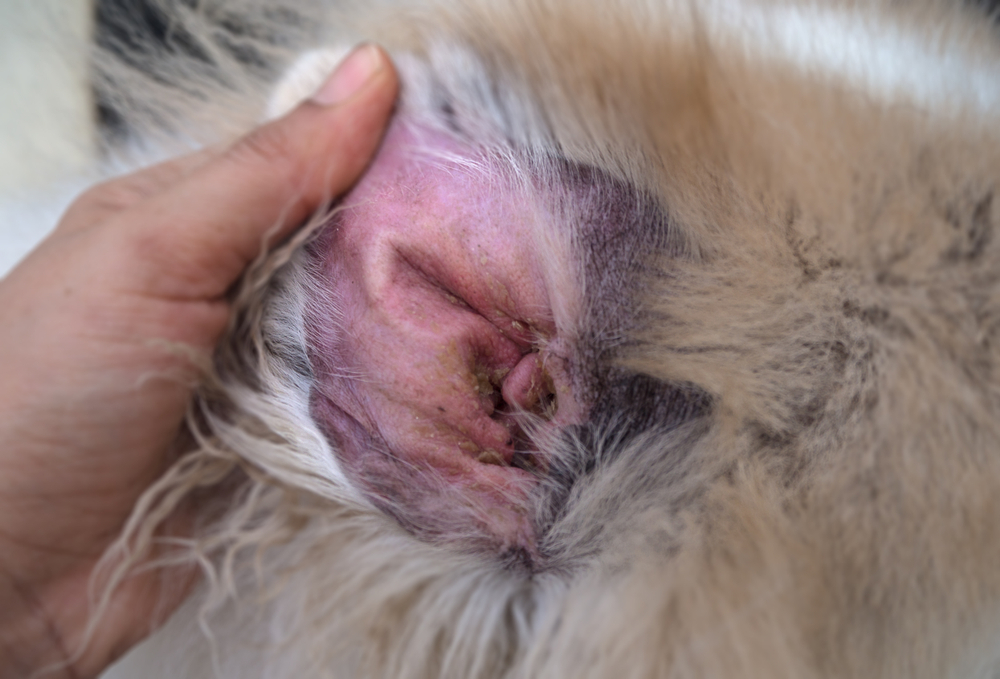Chronic ear infections are painful for dogs and perplexing for their owners. This month, the Sale Creek Veterinary Services team answers your most frequent questions about this frustrating—and seemingly endless—condition.
Question: Why do dogs get ear infections?
Answer: Dogs commonly get ear infections for several reasons, including:
- Ear canal structure — The canine ear canal is L-shaped, with a vertical and horizontal component. And, although this protects the fragile ear drum, the design also creates an ideal environment for debris accumulation.
- Ear set — Long, low-hanging ears in some breeds (e.g., Basset hounds, poodles, spaniels) occlude the ear and block adequate air flow.
- Ideal bacteria conditions — The canine ear canal is dark, warm, and moist, and the perfect environment for bacteria and yeast to divide and multiply.
- Allergies — Ear infections can occur as part of an inflammatory reaction. Dogs with recurring ear infections or other clinical signs (e.g., itchy skin, hair loss) should be evaluated for environmental or food-related allergies.
Q: What are ear infection signs in dogs?
A: Early identification and treatment are the best methods for controlling ear infections. Fortunately, many subtle signs precede a full-blown painful infection. If your dog has a history of ear infections, stay alert for early warning signs, including:
- Increased scratching
- Head shaking
- Facial rubbing
- Pawing at the ears or head
- Head tilt
- Odor
Q: I cleaned my dog’s ears—why are they still shaking their head?
A: Ear cleaning can be a great way to maintain your dog’s ear health, but may not be effective against an already-present infection. Head shaking may also indicate primary conditions, such as eardrum rupture, ear canal tumor, or a foreign object (e.g., grass awn, tick, seed) inside the ear. An otoscopic exam at Sale Creek Veterinary Services is the only way to evaluate your pet’s horizontal ear canal and find these or other underlying conditions.
Q: Why does my dog’s ear infection keep coming back?
A: Each dog’s health is individual and complex. Some common causes or contributing factors for recurrent ear infections can include:
- Incomplete treatment — Discontinuing at-home medication before the treatment is complete can create bacterial resistance. Always follow the labeled instructions and ensure you complete the whole treatment course. Contact Sale Creek Veterinary Services with any questions or concerns.
- Mixed bacterial infection — Sometimes an infection can be caused by more than one bacteria, and the infection will persist if the prescribed medication is not effective against all species. In these cases, additional testing (i.e., a culture and sensitivity) is necessary to isolate each organism and determine an effective treatment.
- Underlying cause — Infection can be secondary to another condition, which may not reveal itself right away. Also, an infected ear that is too swollen, painful, or constricted to allow a complete otoscopic exam may prevent a diagnosis of the underlying cause (e.g., foreign body, tumor). Attending each follow-up appointment allows us to ensure the infection has resolved and take a more complete—and more comfortable—look at your pet’s internal ear canal.
- Allergies — Continuous allergen exposure keeps the body in an inflamed state that makes recurrent irritation and infections more likely.
Q: Why do my dog’s ears look like cauliflower?
A: Chronic inflammation from allergies or untreated infections causes ear tissue to proliferate and thicken, resulting in a cauliflower-like appearance. These ear changes (i.e., hyperplasia) can make cleaning and treatment a challenge, and often result in a narrowed or occluded ear canal that requires surgery to re-open the ear canal.
Q: What are the treatment options for dogs with chronic ear infections?
A: Relief for pets’ chronic ear infections is possible, but the owner must be dedicated and persistent. Fortunately, effective, convenient treatments are widely available for each specific circumstance.
- Medication — Your veterinarian may use a combination of anti-inflammatory and antibiotic or antifungal medications to reduce tissue inflammation, ease pain, and address the infection. In addition to daily ointments, long-lasting single-dose medication is available. If environmental allergies are suspected, allergy medication can minimize the risk of return.
- Diet change — Switching your dog to a limited ingredient diet containing a novel (i.e., unique to them) protein may eliminate food allergy-related inflammation.
- Surgery — Surgery may be necessary to remove foreign objects and obstructive tumors. For narrow (i.e., stenotic) ear canals, your veterinarian may recommend a total ear canal ablation (TECA) surgery, where they remove and reroute the ear canal.
Q: What can I do to promote my dog’s ear health?

A: Prevention is the best cure, but with chronic ear infections, you may find you can’t beat Mother Nature. Long-eared breeds and dogs with narrow ear canals will always be vulnerable to this frustrating condition, although preventive steps and routine care can minimize risk and limit ear infections. Proactive measures include:
- Weekly cleaning — Clean your dog’s ears weekly with a veterinary-recommended cleaner. Use this time to look for early infection signs.
- Prompt treatment — Don’t try to manage ear infections at home—ensure effective resolution and relief for your pet by seeking veterinary care at the first sign.
- Mindful grooming — If your dog has hairy ears, ask your groomer to shave inside their ear flap and to pluck any hair in the canal to promote air flow.
- Attentive aftercare — Inspect your dog’s ears after swimming, bathing, or hiking in tall grass. Clean and dry their ears completely after water exposure, and comb ear feathering to check for grass awns and other seeds.
Don’t let chronic ear infections rule your dog’s life—or yours. Trust your furry friend’s total health to Sale Creek Veterinary Services. Contact our expert team to schedule your dog’s next appointment.







Leave A Comment